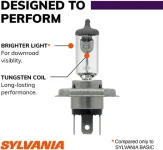https://jalopnik.com/why-most-led-headlight-upgrades-dont-really-work-an-ex-1843070472
Why not just use an LED that is exactly the same size and shape as a regular bulb?
As Stern explains: “Longitudinal position of the light source (where the light source starts and ends, as measured from the base plane of the bulb) is only one critical aspect.” But it’s not the only thing that matters. “Others include shape, size, orientation, and luminance distribution. Getting one out of five right is better than zero out of five, but it’s still 20 percent, a badly failing grade.”
“If we could wave a magic wand and come up with a cylindrical LED emitter of the same dimensions as a filament, with the necessary luminance and flux, then the incompatibility would vanish. That is not technically possible for the foreseeable future, so we have basically two-dimensional flat LEDs in place of a three-dimensional cylindrical filament.”
“There is significant space between the two back-to-back flat LEDs (there has to be, otherwise no material to carry away their heat), so now our light source is radically different from a filament in shape, size, position, and light distribution even if we’ve taken great care to put the emitters at exactly the same longitudinal position as the original filaments.”
...LEDs in housings designed for halogen bulb replacements put the wrong amount of light in the wrong places...
Will LED Headlights Ever Be A Worthy Upgrade For More Cars In The Future?
“There are technical working groups worldwide (SAE in America, GTB in Europe/Asia) actively working to develop a technical standard for LED retrofit bulbs to replace halogen bulbs in headlamps, fog lamps, and other such,” Stern told me, as member of such groups himself.
As for the current state of technology, Stern says: “Unlike ‘HID kits’ where there is no possibility of optical compatibility, that possibility does theoretically exist with LEDs. The products presently on the market are not close to acceptable; there are still some very substantial technical hurdles to overcome... but eventually, there will be legitimate products of this kind.”
“It’s hard to wait (believe me, I know!) but the ones on the market now just don’t cut it, no matter whose name is on the box and what promises and claims are made.”

